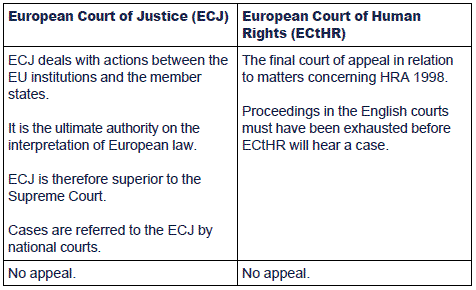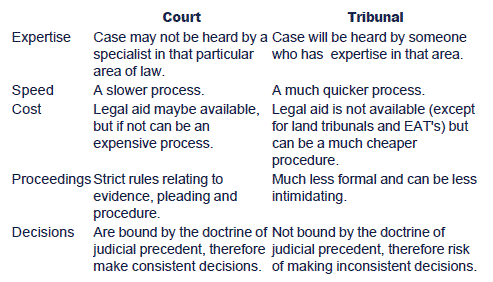The court system
The main English civil courts
The following diagram shows the main civil courts. The term 'first instance' refers to the court in which the case is first heard. Appeals are heard in a different court. The arrows show the way a case will progress through the court system.
The House of Lords was replaced by the Supreme Court on 1 October 2009. This new court has assumed the judicial functions of the House of Lords. The Law Lords that used to sit in the House of Lords now sit as twelve Justices of the Supreme Court, with a President at its head.
The Supreme Court was established by the Constitutional Reform Act 2005. It was felt that there needed to be a separation of powers between the judicial functions of the House of Lords (to decide issues in relation to the law) and the legislative functions of the House of Lords (to make the law) to give assurance of the independence of the judges.
The Supreme Court is now in a separate building from the House of Lords and has its own appointment system, staff and budget.
The three-track system
When a claim is received, it will be allocated to one of three tracks for the hearing.
- The small claims track - deals with simple claims valued at no more than £5,000, an informal court.
- The fast-track - deals with moderately valued claims of between £5,000 and £25,000, expected to last no more than one day.
- The multitrack - deals with claims of over £25,000 and/or complex claims.
Note: the County court deals with all cases allocated to the small claims track, the majority of fast track and some multi track cases. All other claims are dealt with by the High Court.
Other civil courts

The main English criminal courts
Tribunals
Tribunals are also an important part of the English legal system and are an alternative to using the court system to settle a dispute.
In the past, tribunals had been created on an ad hoc basis to perform various judicial functions, for example Employment Tribunals and Asylum and Immigration Tribunals. The tribunals' members were a mixture of judges, lawyers, experts and laypeople, and were regulated by various government departments and bodies. Though these tribunals were supervised by and had rights of appeal within the UK court system, a reform was recommended to create a unified and simplified structure which was better integrated into the courts system.
The Tribunals, Courts and Enforcement Act 2007
The Act made various reforms with regards to tribunals in particular the structure of tribunals.
Section 1 of the Act recognises legally qualified members of tribunals as members of the judiciary of the United Kingdom who are guaranteed continued judicial independence.
Section 3 of the Act creates two new tribunals to which existing jurisdictions will be transferred, a First-tier Tribunal and an Upper Tribunal.
The First-tier Tribunal is divided into six chambers:
- General Regulatory Chamber
- Social Entitlement Chamber
- Health, Education and Social Care Chamber
- War Pensions and Armed Forces Compensation Chamber
- Tax Chamber
- The Immigration and Asylum Chamber.
The main functions of the Upper Tribunal are to
- take over hearing appeals to the courts, and similar bodies from the decisions of local tribunals
- decide certain cases that do not go through the First-tier Tribunal
- exercise powers of judicial review in certain circumstances ; and
- deal with enforcement of decisions, directions and orders made by tribunals.
There is a right of appeal to the Court of Appeal of England and Wales.
Some tribunals will still lie outside the new system.
Employment tribunals
Employment tribunals are established to hear disputes between an employee and their employer on certain statutory employment matters, such as unfair dismissal.
Employment tribunals are composed of one employment judge, plus two expert laymen who are drawn from panels representing both sides of the industry.
Appeals are to the employment appeal tribunal (EAT) and can only be made on a point of law.
The EAT is composed of one High Court judge, plus two or four expert laymen.
Court v Tribunal

|
Created at 8/20/2012 9:05 AM by System Account
(GMT) Greenwich Mean Time : Dublin, Edinburgh, Lisbon, London
|
Last modified at 11/14/2012 1:53 PM by System Account
(GMT) Greenwich Mean Time : Dublin, Edinburgh, Lisbon, London
|
|
|
|
 |
Rating
:
|
 Ratings & Comments
(Click the stars to rate the page) Ratings & Comments
(Click the stars to rate the page)
|
 |
Tags:
|
|
|
|
|